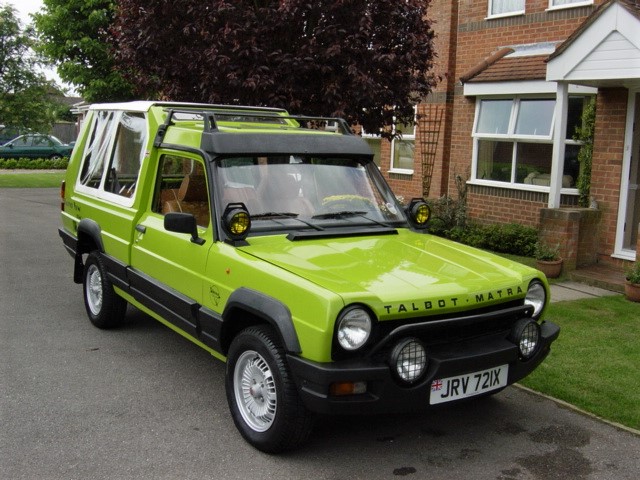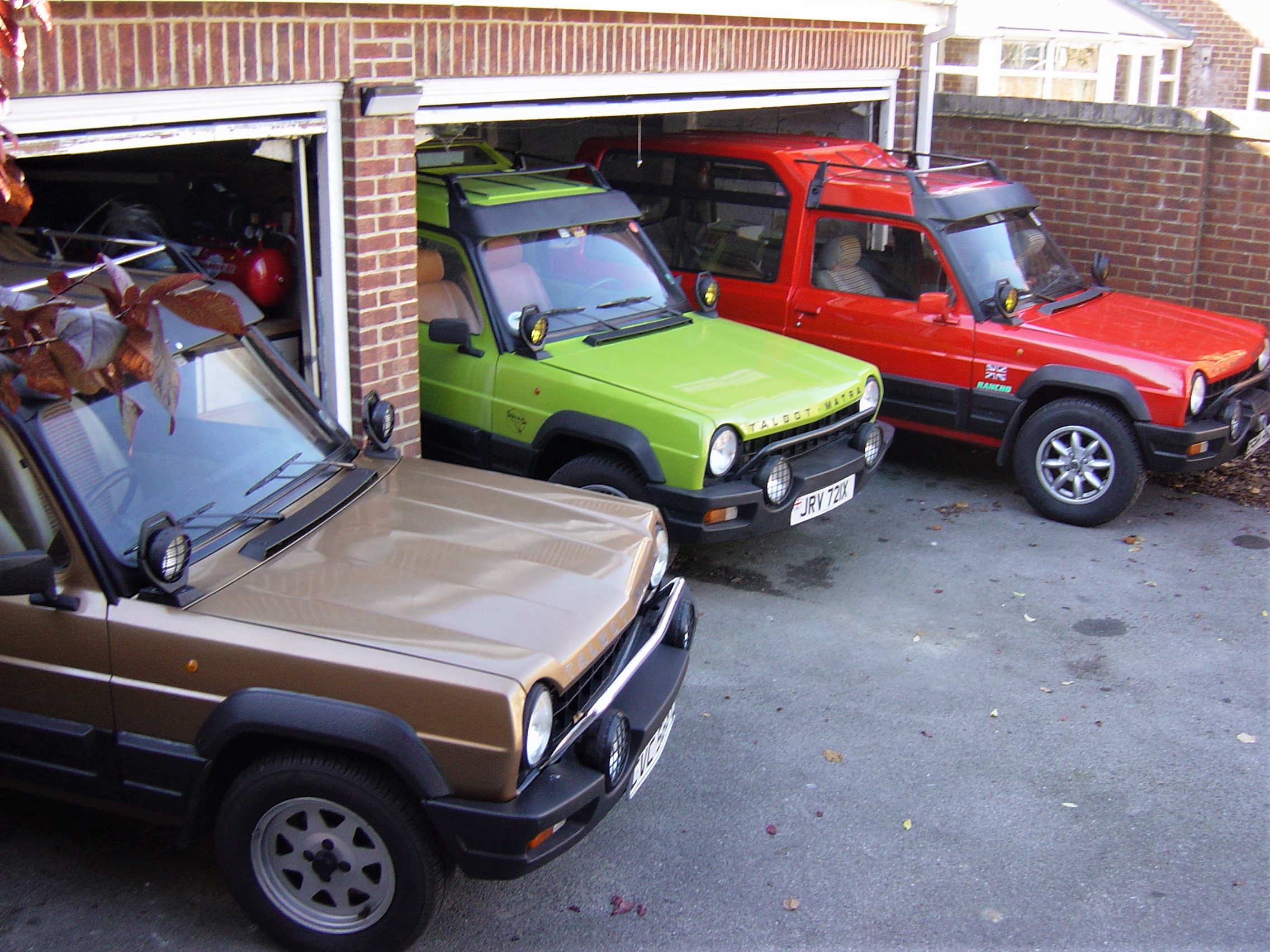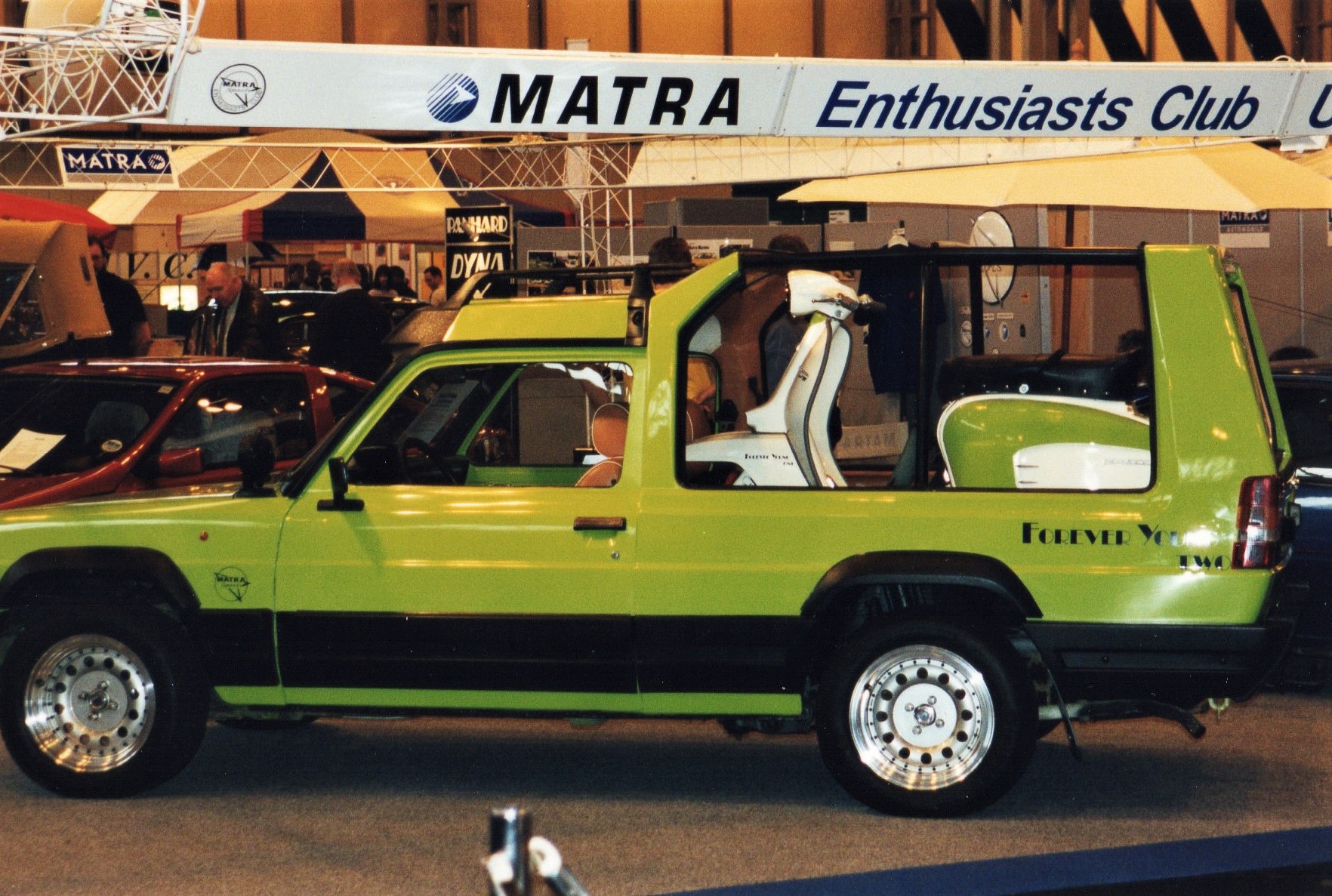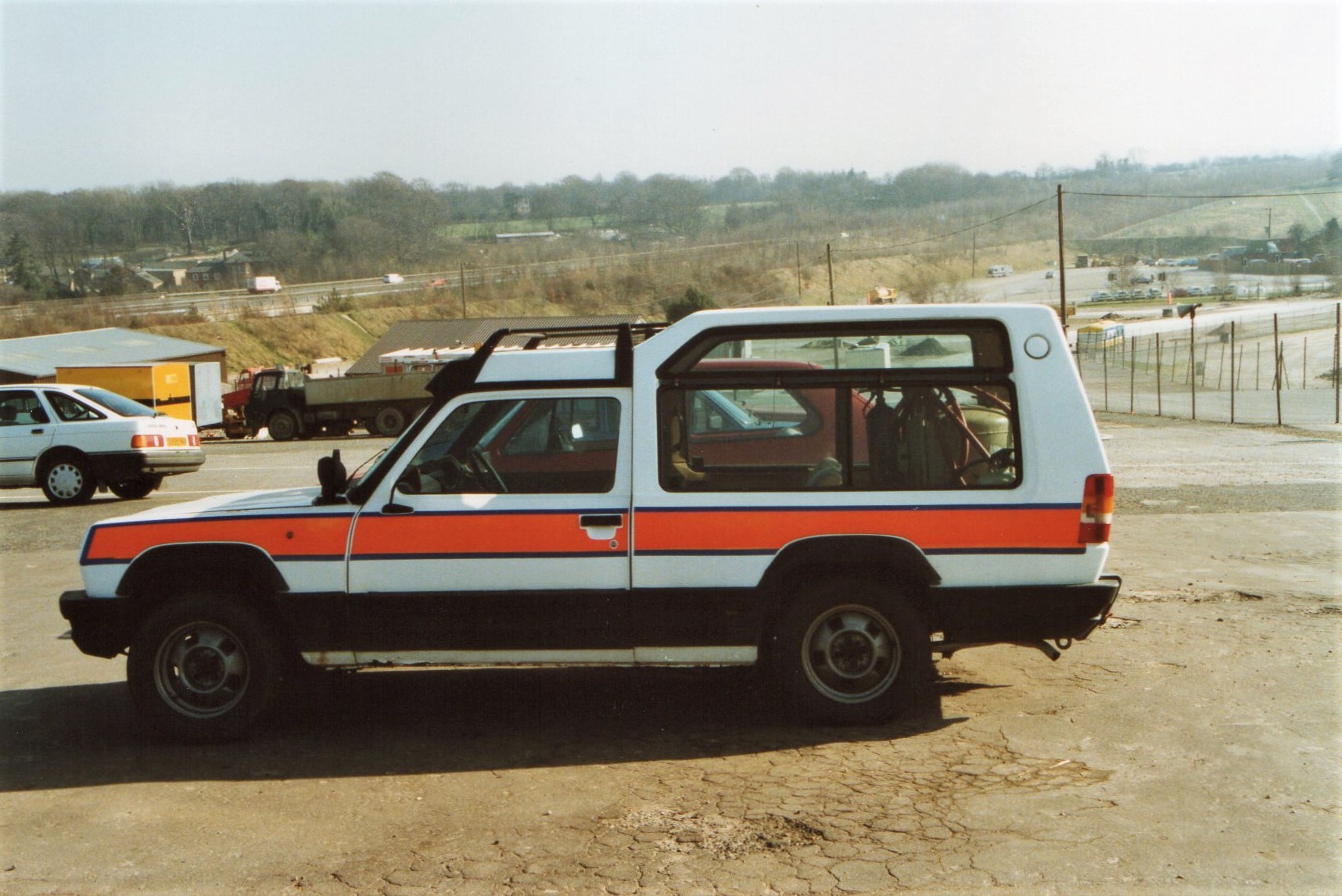"The Matra Rancho Wind dates from the nanosecond when windsurfing was cool. Yes, dear reader, 1980. It's obviously a chopped version of the rump Simca Rancho- which in turn was almost like a budget, down at heel version of the Range "

Matra Rancho: the green car
Is there such thing as a typical Matra owner?
Its makers considered it to be a voiture verte and marketed it accordingly, but if you were to look at the Matra Rancho with 21st century eyes you’d probably conclude it is no more a green car than it is a contender for victory in the Indy 500. After all, it’s as aerodynamic as a freight shed, has a petrol engine that was obsolescent back in the 1970s and doesn’t come close to redefining anyone’s concept of fuel efficiency.
If so, you’d be right. And wrong. Four decades ago, you see, a green car wasn’t one that was environmentally friendly, but one that could take people and their leisure or sporting equipment into environments that lay off the beaten track; in other words, it was a car for those who wanted to get a bit closer to nature.
And whilst it’s true that the Rancho owes its existence to an energy crisis, it was one whose roots lay in war rather than environmental concerns. The crisis had deep and significant repercussions on a global basis, not least on the sales of sports cars. As a company whose sole product was a voiture sportif, albeit a fuel-efficient one, Matra Sports found itself in an uncomfortably vulnerable position. This led Matra’s chief engineer Philippe Guédon to conclude that diversification was essential if the company was to survive in an uncertain world.
So with the success of the Range Rover very much in mind, Guédon proposed to Jean-Luc Lagardère, Matra’s Managing Director, that the company should produce a new type of vehicle, a voiture verte. Lagardère agreed, but stipulated that the new car had to be produced quickly and cheaply.

It’s said by some that the Range Rover wasn’t Matra’s sole inspiration and that a very low-volume Spanish car, an ungainly looking Simca-based creation called the Campero, may also have been an influence. And although the rough and ready Campero – whose looks suggested that its designer had worn a blindfold – bore little relation to the infinitely more polished Rancho, it’s conceivable that there may be some truth in the story.
Either way, Philippe Guédon found himself with a budget that ultimately ran to a mere 15,000,000 francs (about £1.6 million pounds) with which to quickly create his voiture verte. But cost and time weren’t the only constraints: Matra’s commercial ties with Chrysler Europe meant Guédon and his team had to source components from the somewhat underwhelming Simca parts bin.
Given his meagre budget, Guédon had little option but to use an existing product – the Simca 1100 pickup – as a basis for the new car, now known as the P12. But by the time Matra’s engineers and designer Antoine Volanis had worked their magic, the P12 looked more like a Range Rover that had spent time in the gym than the medium-sized light commercial vehicle from which it had been developed.
To create the P12, the changes made to the 1100’s structure were significant and included lengthening and strengthening the platform, replacing the bodywork aft of the front seats with a tall and airy glass-fibre rear section on a steel frame and increasing the ride height to 21 centimetres at the front and 26 at the rear. The 1442cc engine from the Simca 1307/8 (better known in the UK as the Chrysler Alpine) was fitted, along with the brakes from the sporty TI version of the 1100. A more substantial grille and bumpers were added, the roof of the front section gained a visor and built-in roof rack, and matt black wheel-arch extensions and rubbing strips were added. Interior alterations included the fitting of front seats from the Simca 1307/8 and the raising of the rear seats by 10cm.

Lagardère had asked that the new car be production-ready as soon as possible and Guédon did not disappoint: having started work on the P12 project in 1975, it was shown in production form at the Geneva Motor Show in March, 1977, with deliveries to dealers commencing two months later. And now it had a name: the Matra-Simca Rancho (save for Italy, where it was called the ‘Ranch’).
Although Matra had carried out some experiments with an ingenious electrically-powered four-wheel drive system, only the front wheels of production Ranchos would be driven. Consequently, although the Rancho could cope with more rugged terrain than the average car was able to, it lacked the ability to tackle conditions that were meat and drink to, say, a Range Rover. But then it was never intended to be a full-blown off-roader. Rather, it was designed to cater for people – such as those who enjoyed outdoor pursuits – who needed a car that had some off-road ability but was also good to drive on urban roads and highways.
The Rancho was never marketed as a hard core all-terrain vehicle (one UK advert featured a Rancho parked in the wilds of, er, Knightsbridge), but its rugged looks undoubtedly helped to fuel a divergence of opinion that continues to this day. You either, like Car magazine’s legendarily idiosyncratic scribe, L.J.K. Setright, ‘got’ the Rancho or, like Setright’s colleague Mel Nichols, you didn’t.
It’s perhaps understandable, then, Chrysler was initially less than entirely convinced that the Rancho would find sufficient buyers to justify its existence. Indeed, one Chrysler France executive is said to have told Matra that they didn’t expect to sell more than fifteen Ranchos a month.
The Rancho had no sooner hit the showrooms than it unwittingly found itself at the centre of an embarrassing international affair. The Cold War was still showing little sign of thawing when, in June, 1977, Leonid Brezhnev, the Chairman of the Communist Party of the Soviet Union, made a state visit to France. For Brezhnev, the visit didn’t just offer the opportunity to engage in face-to-face talks with French President Giscard d’Estaing, but also the chance to add to his impressive car collection.

During a previous visit to France in 1971, Brezhnev had been presented with a Citroën SM as a gift. This time, however, the French went one better and gave him two cars: a Matra-Simca Bagheera and a Rancho. Unfortunately, the Rancho which had been chosen was green, a colour Brezhnev thought to be unlucky. And that wasn’t all he didn’t like about it – the tan-coloured seats were not to his taste. It was hastily suggested that a blue Rancho with brown seats might be offered instead. The only snag being that the Rancho wasn’t then available in blue…
The solution, as U.S. President Jimmy Carter learned in a memo from his National Security Adviser, was to rush the green Rancho back to the factory and repaint it blue. The memo might also have added that the seats were also replaced with ones in Brezhnev’s preferred hue. Mere mortals would, however, have to wait a little longer before they could get their hands on a blue Rancho…
Other models would later join the range, but the Rancho was initially available only in a single specification, albeit with an options list that included useful extras such as underbody protection, scuttle-mounted spotlights, alloy wheels and tinted glass. That list was soon augmented by the addition of a full-width folding bed which sat above the level of the rear wheel-arches. So if you’ve ever wondered why the Rancho’s rear compartment is so tall, you need wonder no more.
Unlike previous Matras, the Rancho was produced in right-hand-drive form. Imports to the UK commenced in 1978, but the asking price of £5650 was somewhat higher than the £4200 tag it carried in its native France. The UK model did, however, come with a higher level of standard equipment. It also differed from its European-market siblings by carrying ‘Matra’ rather than ‘Matra-Simca’ branding.
In late 1978, Chrysler Europe was purchased by Peugeot. With Matra having reached an accord with Peugeot to continue production of the Rancho and Bagheera (and launch the latter’s replacement in 1980), it might have seemed that the path lay open for Matra to develop the Rancho using Peugeot-sourced components. Any chance of this happening, however, was practically annulled when, firstly, Peugeot found themselves in financial trouble and, secondly, when they later declined to green-light Matra’s P18 prototype for production – a costly decision, given that the P18 evolved into the Renault Espace.

The Rancho had, therefore, to soldier on without significant development. A series of new variants were, however, produced from the 1980 model year onwards. Initially, three new models were offered: the A.S., a commercial version which was built without rear seats and thereby subject to a lower rate of purchase tax in France; the X, an upmarket version with alloy wheels, tinted glass, more comprehensive instrumentation and a load area cover as standard; and the Grand Raid, slightly more focused towards off-road use and equipped with a lower-compression engine, underbody protection, an electrically-powered winch, scuttle-mounted spotlights, two off-road tyres and the wonderfully named Antibog (a limited-slip differential) as standard. None of these new models came to the UK.
A convertible version followed in 1980. This model, the Découvrable, featured a rear compartment with detachable panels made of canvas and flexible transparent plastic. As with the base model, an A.S. version of the Découvrable was offered. A combined total of 595 of both versions was built. Needless to say in light of our weather, it wasn’t sold in the UK. Indeed, only one model of the Rancho was ever offered to buyers on this side of the Channel, albeit its specification was periodically amended.
The Rancho, which now sported ‘Talbot-Matra’ branding in all markets, continued to sell steadily, lack of development notwithstanding. It might have stayed in production a little longer but Matra’s decision to part company with Peugeot meant that Rancho production ceased in 1983, after a total of 56,457 had been built – more than twice as many as Matra had hoped to sell.
So much for the history, what about the Rancho today? As there’s no-one better placed in the UK to comment on the Rancho than Clive Nelson, President of the Matra Enthusiasts Club UK and Rancho owner since 1984, we asked him for his assessment.
“There aren’t many Ranchos left anywhere”, says Clive. “Most of them either rusted away – don’t believe anyone who says later ones were galvanised, they weren’t – or got to an age where they became bangers and were scrapped when the owner was hit with a big repair bill. I used to get people phoning me, all excited that they’d bought a Rancho. The next time I’d hear from them would usually be a couple of weeks later, when they’d be asking me if I’d like to buy it off them!”
“As far as I know”, he adds, “of the 6,000 or so Ranchos that were imported to the UK, only a handful remain in roadworthy condition. No-one knows exactly how many are left in Europe, but I’d be surprised if there are more than a couple of hundred still on the road. I’d like to think that those that are left will continue to survive. You can still get mechanical parts without too much difficulty, but trim items and parts unique to the Rancho are hard to find. That’s where the owners’ clubs can help out.”
In spite of the Rancho’s rarity, Clive still uses his regularly and sometimes takes it off-road. “My car is fitted with a winch – I beefed up the mounting plates as the originals were too flimsy. In fact, I had only just fitted it when I used it to recover a car that had got stuck in gravel. I’ve also added a limited-slip differential to my car. It’s not very sophisticated but does improve its off-road ability a bit in certain conditions. You have to remember, though, that the Rancho was intended to be a leisure car rather than a true off-roader.”
As for Clive’s verdict on the Rancho, he’s still very much a fan. “For me, Matra got it right. Yes, it would have been even better with a different engine and four-wheel drive, but they were working on a tight budget and had to use what was available to them. Even with the benefit of hindsight, I can’t really think of anything I’d have done differently had I been in their shoes – except give it better protection against rust! We shouldn’t forget just how far ahead of its time the Rancho was. Soft-roaders and crossovers may be common nowadays, but back in the Rancho’s day there was nothing else quite like it. Looked at from that perspective, it’s a seminal car.”
Our thanks go to Clive Nelson for his invaluable assistance with this article.
CLICK TO ENLARGE










